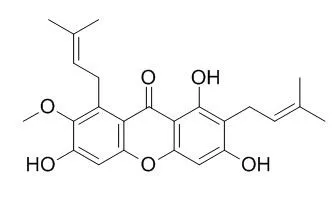| Kinase Assay: |
| Bioorg Med Chem. 2004 Nov 15;12(22):5799-806. | | Preferential target is mitochondria in alpha-mangostin-induced apoptosis in human leukemia HL60 cells.[Pubmed: 15498656] | Our previous study has shown that alpha-Mangostin, a xanthone from the pericarps of mangosteen, induces caspase-3-dependent apoptosis in HL60 cells. In the current study, we investigated the mechanism of apoptosis induced by alpha-Mangostin in HL60 cells.
METHODS AND RESULTS:
alpha-Mangostin-treated HL60 cells demonstrated caspase-9 and -3 activation but not -8, which leads us to assume that alpha-Mangostin may mediate the mitochondrial pathway in the apoptosis. Parameters of mitochondrial dysfunction including swelling, loss of membrane potential (deltapsim), decrease in intracellular ATP, ROS accumulation, and cytochrome c/AIF release, were observed within 1 or 2 h after the treatment. On the other hand, alpha-Mangostin-treatment did not affect expression of bcl-2 family proteins and activation of MAP kinases. These findings indicate that alpha-Mangostin preferentially targets mitochondria in the early phase, resulting in indication of apoptosis in HL60 cells. Furthermore, we examined the structure-activity relationship between xanthone derivatives including alpha-Mangostin and the potency of deltapsim-loss in HL60 cells. Interestingly, replacement of hydroxyl group by methoxy group remarkably decreased its potency. It was also shown that the cytotoxicity substantially correlated with deltapsim decrease.
CONCLUSIONS:
These results indicate that alpha-Mangostin and its analogs would be candidates for preventive and therapeutic application for cancer treatment. | | Cell Biochem Biophys. 2010 Sep;58(1):31-44. | | Alpha-mangostin suppresses phorbol 12-myristate 13-acetate-induced MMP-2/MMP-9 expressions via alphavbeta3 integrin/FAK/ERK and NF-kappaB signaling pathway in human lung adenocarcinoma A549 cells.[Pubmed: 20652762] | The purpose of this study is to investigate the anti-metastatic effect of alpha-Mangostin on phorbol 12-myristate 13-acetate (PMA)-induced matrix metalloproteinase-2 (MMP-2) and matrix metalloproteinase-9 (MMP-9) expressions in A549 human lung adenocarcinoma cells.
METHODS AND RESULTS:
Firstly, alpha-Mangostin could inhibit PMA-induced abilities of the adhesion, invasion, and migration. Data also showed alpha-Mangostin could inhibit the activation of alphavbeta3 integrin, focal adhesion kinase (FAK), and extracellular signal-regulated kinase1/2 (ERK1/2) involved in the downregulation the enzyme activities, protein and messenger RNA levels of MMP-2 and MMP-9 induced by PMA. Next, alpha-Mangostin also strongly inhibited PMA-induced degradation of inhibitor of kappaBalpha (IkappaBalpha) and the nuclear levels of nuclear factor kappa B (NF-kappaB). Also, a dose-dependent inhibition on the binding abilities of NF-kappaB by alpha-Mangostin treatment was further observed. Furthermore, reduction of FAK or ERK1/2 phosphorylation by FAK small interfering RNA (FAK siRNA) potentiated the effect of alpha-Mangostin. Finally, the transient transfection of ERK siRNA significantly down-regulated the expressions of MMP-2 and MMP-9 concomitantly with a marked inhibition on cell invasion and migration.
CONCLUSIONS:
Presented results indicated alpha-Mangostin is a novel, effect, anti-metastatic agent that functions by downregulating MMP-2 and MMP-9 gene expressions. | | Eur J Pharmacol. 1996 Oct 31;314(3):351-6. | | Pharmacological properties of alpha-mangostin, a novel histamine H1 receptor antagonist.[Pubmed: 8957258] |
METHODS AND RESULTS:
In the isolated rabbit thoracic aorta and guinea-pig trachea, alpha-Mangostin inhibited histamine-induced contractions in a concentration-dependent manner in the presence or absence of cimetidine, a histamine H2 receptor antagonist. But KCl-, phenylephrine- or carbachol-induced contractions were not affected by alpha-Mangostin. The concentration-contractile response curve for histamine was shifted to the right in a parallel manner by alpha-Mangostin. In the presence of chlorpheniramine, a histamine H1 receptor antagonist, alpha-Mangostin did not affect the relaxation of the rabbit aorta induced by histamine. In the guinea-pig trachea, alpha-Mangostin had no effect on the relaxation induced by dimaprit, a histamine H2 receptor agonist. alpha-Mangostin caused a concentration-dependent inhibition of the binding of [3H]mepyramine, a specific histamine H1 receptor antagonist to rat aortic smooth muscle cells. Kinetic analysis of [3H]mepyramine binding indicated the competitive inhibition by alpha-Mangostin.
CONCLUSIONS:
These results suggest that alpha-Mangostin is a novel competitive histamine H1 receptor antagonist in smooth muscle cells. |
|
| Animal Research: |
| Biol Res Nurs. 2015 Jan;17(1):68-77. | | Mechanisms of α-mangostin-induced antinociception in a rodent model.[Pubmed: 25504952 ] | Elucidate the antinociceptive mechanisms of alpha-Mangostin isolated from Garcinia malaccensis Linn.
METHODS AND RESULTS:
Male mice/rats (n = 6/group) were used in this between-group study. To determine α-mangostin's antinociceptive profile, animals were given alpha-Mangostin orally (3, 30, or 100 mg/kg) 60 min before the start of the abdominal constriction or formalin tests. To explore alpha-Mangostin's mechanisms of action, we performed (i) the hot plate test with naloxone (5 mg/kg) pretreatment to verify involvement of opioid receptors; (ii) the abdominal constriction test with 20 mg/kg l-arginine, N(G)-nitro-l-arginine methyl esters (l-NAME), methylene blue (MB), l-arginine plus l-NAME, or l-arginine plus MB or 10 mg/kg glibenclamide pretreatment to verify involvement of the l-arginine/nitric oxide (NO)/cyclic guanosine monophosphate (cGMP) and K -ATP pathways; and (iii) the paw-licking test using capsaicin (1.6 μg capsaicin/paw), glutamate (10 μmol glutamate/paw), or phorbol 12-myristate 13-acetate (PMA; 0.05 µg/paw) to verify involvement of vanilloid receptors, the glutamatergic system, and protein kinase C (PKC). RESULTS: alpha-Mangostin significantly inhibited nociception (p < .05) in all models. Only naloxone, l-arginine, methylene blue, PMA, and glibenclamide affected alpha-Mangostin antinociception significantly (p < .05).
CONCLUSIONS:
alpha-Mangostin exhibits peripheral and central antinociception through modulation of opioid and vanilloid receptors, the glutamatergic system, and the l-arginine/NO/cGMP/PKC/K( )-ATP pathways. |
|






 Cell. 2018 Jan 11;172(1-2):249-261.e12. doi: 10.1016/j.cell.2017.12.019.IF=36.216(2019)
Cell. 2018 Jan 11;172(1-2):249-261.e12. doi: 10.1016/j.cell.2017.12.019.IF=36.216(2019) Cell Metab. 2020 Mar 3;31(3):534-548.e5. doi: 10.1016/j.cmet.2020.01.002.IF=22.415(2019)
Cell Metab. 2020 Mar 3;31(3):534-548.e5. doi: 10.1016/j.cmet.2020.01.002.IF=22.415(2019) Mol Cell. 2017 Nov 16;68(4):673-685.e6. doi: 10.1016/j.molcel.2017.10.022.IF=14.548(2019)
Mol Cell. 2017 Nov 16;68(4):673-685.e6. doi: 10.1016/j.molcel.2017.10.022.IF=14.548(2019)